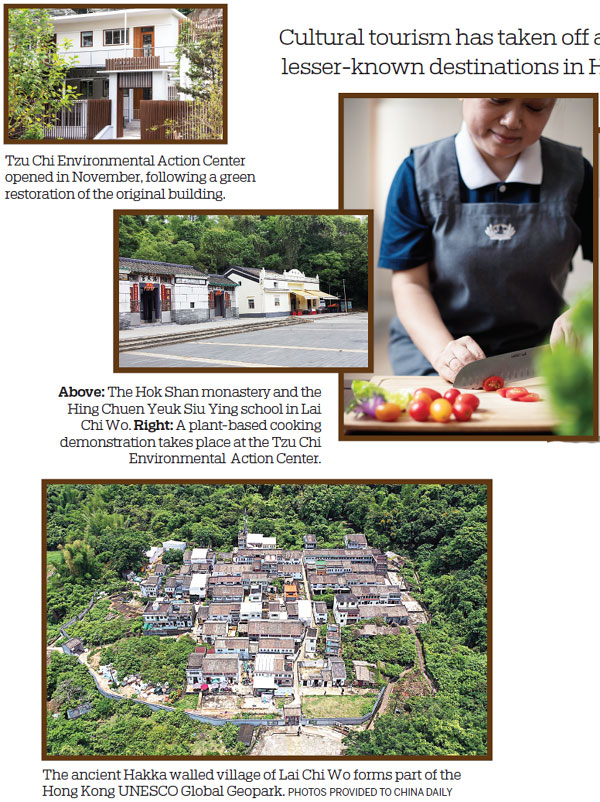Hidden gems in your backyard
Cultural tourism has taken off as more people are discovering lesser-known destinations in Hong Kong. Rebecca Lo takes a walk on the wild side.


A visit to Lai Chi Wo requires commitment. Energetic day trippers can hike 16 kilometers from Wu Kau Tang through Plover Cove Country Park to get there. Alternatively, there is a single daily ferry departing weekends from Ma Liu Shui pier near University MTR station.
The 90-minute ride transports culture seekers to a three-centuries-old Hakka village near Sha Tau Kok's border with Shenzhen. Formerly the ancestral home of the Wong and Tsang clans, the walled compound housed 600 villagers in its heyday. In recent decades, as families moved into urban Hong Kong or emigrated abroad, it was abandoned.
Through efforts by the Centre for Civil Society and Governance at the University of Hong Kong, with support from HSBC, Lai Chi Wo is getting a new lease on life as a self-sustaining community. It was recognized with a UNESCO Asia-Pacific Award for Cultural Heritage Conservation in 2020 and a citation by the American Institute of Architects Hong Kong Chapter (AIA HK) in 2021.
Lai Chi Wo is popular with city slickers seeking slower Sundays involving harvesting crops and feasting on traditional Hakka dishes, if only for a few hours. Group tours are available through the Hong Kong Countryside Foundation, established in 2011 by Sir David Akers-Jones and Leung Chun-ying, who a year later would become Hong Kong's third chief executive. The NGO aims to be a vehicle for involving the public in countryside conservation.
Lai Chi Wo is one of many cultural tourism endeavors that have popped up to meet demand as Hong Kong people venture off their couch and into the jungle. Faced with strict travel restrictions, those with itchy feet and holiday leave to spend are seeking enriching activities on home ground.
Last month, Slow Food Hong Kong organized a day tour of Lai Chi Wo that included a Hakka lunch and ginger harvest exercise for parents and children. In May, AIA HK crafted a Lai Chi Wo excursion with a focus on conserving the village's stone houses. Architect Vicky Chan, the initiative's organizer, spotlit community efforts toward self-sufficiency through sustainable agriculture and tourism with a guided tour of Lai Chi Wo's farm and greenhouse.
Local cafes and shops do a brisk trade on weekends, when visitors arrive by the boat load. Snack vendors selling biscuits and wife cakes - stationed at the village entrance, by a tourist center that was formally Siu Ying Primary School - welcome hungry arrivals fresh off the boat.
Enter the village walls, and you'll find Very Ginger HK, which specializes in products made from locally grown turmeric and ginger. Along with souvenirs, the store sells turmeric-flavored ice pops during summer and nourishing teas in winter. For those seeking more substantial fare, Ming Kee and Foo's Cafe dish up Cantonese favorites including the former's chicken rice congee special.
Those seeking greener pastures will find distractions aplenty. A nature trail closely follows the village walls and snakes up the hill to Five-Finger Camphor, so named because the tree's roots resemble a hand. To the south of the village are pastures where crops such as coffee beans are grown.
"It's refreshing to see this side of Hong Kong," says American architect J Lee Rofkind, a participant in the AIA HK tour. "Lai Chi Wo feels like another world."
The first Saturday of every month, budding and established farmers convene at the Lai Chi Wo Farmers' Market to swap stories and sell produce. This and Lai Chi Wo's many small businesses exemplify the village's slower pace of life combined with the retail savvy of Hong Kong entrepreneurs.
- Convention on Wetlands chief praises China's conservation efforts
- Nanshan Mountain shrouded in mist at dawn
- NW China province issues red alerts for flash floods, geological disasters
- Portuguese students enjoy cultural activities in Tianjin
- Hainan's 72 shipping lines deliver goods across the globe
- Northern China issues alerts for rainstorms, flooding




































